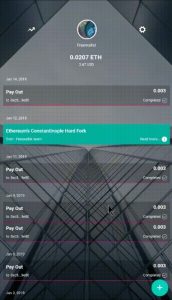Contents
The index finger of the left hand in such a way that they make an angle of 90 degrees and the conductor placed in the magnetic field experiences Magnetic force. In 1820, Oersted showed that a current carrying conductor produces magnetic fields around it. I.e. if you place a compass near a current carrying conductor it will show some deflection. The intensity of magnetic field at any point near a current carrying conductor can be determined by Biot-Savart’s law. B indicates the magnetic field, I indicates the induced current and V indicates the movement of the conductor in the magnetic field. The magnetic effect of electric current can also be easily shown by placing a magnetic compass near a wire which is carrying electric current.
The direction of the magnetic lines of force around the wire is given by right-hand-thumb-rule. So this rule is also known as Maxwell’s right hand thumb rule. Of the circular magnetic field lines can be given by Maxwell’s right-hand grip rule or Right handed corkscrew rule. This rule called in right hand gripping rule ‘Fleming’s Right-hand rule’, helps us to find out the direction of the induced current in the moving conductor placed in a magnetic field that is perpendicular to the direction of the movement of the just mentioned conductor. This rule helps to understand and explain the Generator effect.
Let’s say the current flowing the conductor is 5 A, length of the rod be 4m and the magnetic field generated by 3 T. Instead of placing a current-carrying conductor in a magnetic field, we will place just a conductor initially, without any current flowing through it. So just a conductor is what is required to be in the magnetic field and yes, it’s to be placed at a right angle to the direction of the magnetic field present; no need for any battery and switch.
And this time the conductor is given a movement at a right angle to the magnetic field. So are you getting the difference between this setup with the previous one? The previous one dealt with a conductor which is already carrying a current. When it’s placed in a magnetic field at a right angle, then it would result in a deflection or movement in the conductor.
State Maxwell’s right hand grip rule.
The next table lists the important differences between Fleming’s left-hand and right-hand rules. Magnetic field, Current through the conductor, and the force experienced by the conductor RESPECTIVELY. Magnetic Field and a conductor (maybe current-carrying or not carrying, may be static or moving) can have different mutual effects in different scenarios, based on some specific conditions.
To resolve this issue, we use the commutator and a carbon brush for a complete rotation of the loop to avoid distortion in the wire, as we can see in Fig. The orange wires would try to distort the loop, as the loop is of very high strength and the spinning of the loop won’t be there at this moment. Here, we would consider these two forces as negligible.
- Which shows the lines of force of the magnetic field around a wire are in the form of concentric circles.
- However, in the case of the electric field, the source of the electric field is an electric charge.
- When it’s placed in a magnetic field at a right angle, then it would result in a deflection or movement in the conductor.
- Here, in the above diagram of the electric motor, we notice that each side of the loop behaves as a current-carrying conductor.
- Electromagnetism is a branch of physics that describes the interactions of electricity and magnetism.
So here cause is the movement of a conductor in a magnetic field at a right angle and the result is the generation of current flow through the moving conductor. Shows the direction of induced current when a conductor attached to a circuit moves in a magnetic field. It can be used to determine the direction of current in a generator’s windings. Right Hand thumb rule Corkscrew rule Suppose we are holding a straight current carrying wire in our right hand.
Maxwell Corkscrew rule
Or , both the rules predict that magnetic field lines will be in an anticlockwise direction when seen from above. Biot-savart’s law tells that the direction of magnetic field at any point near a current carrying conductor will be perpendicular to the plane containing the conductor and the position vector of the point with respect to the wire. But if you take a straight current carrying wire which passes through a card-board perpendicularly and put some iron dust, the dust will rearrange them in concentric circles. Which shows the lines of force of the magnetic field around a wire are in the form of concentric circles.
Danish Physicist H.C. Oersted noted this first in 1820. Generation of an electromotive force in the conductor which results in an induced flow of current through the moving conductor. But in this case, no current needs to flow initially through the conductor.

Let’s list down a few such incidents of electromagnetism and the rules defining these incidents. Point the pointed tip of the corkscrew in the direction in which the current is flowing. Draw the series combination circuit diagram derive the essential formula to https://1investing.in/ calculate the equivalent resistance. The direction of these circular magnetic lines is dependent upon the direction of the current. A magnet produces a magnetic field in the space around it. This field exerts a force on any other magnet placed in that field.
Difference between Fleming’s left and right-hand rule
Carbon brushes are just touching the Commutator and are linked with wire, so that if the current reaches the loop via these brushes.
An experimental setup can be prepared using a horseshoe magnet and a thick copper wire connected to a battery via a switch. Here we can find that the current-carrying conductor wire deflects due to a force generated by the magnetic field of the magnet present nearby. So, if the magnetic field B is parallel to the orange wire, no force would act upon it, so how will the loop rotate? It’s because forces acting in opposite directions make the loop rotate. We have also listed down the major differences between Fleming’s left-hand rule and right-hand rule.

Again a magnetic field can induce the movement of charges . But one thing we can see in orange wire, the current is flowing in the right direction while magnetic field B is in the left direction. The current and magnetic field is in the opposite direction.
It’s vital to note that these rules don’t define magnitude; rather, they demonstrate the direction of the three parameters when the other two parameters’ directions are known. Electric motors are predominantly affected by Fleming’s Left-Hand Rule, while electric generators are primarily affected by Fleming’s Right-Hand Rule. When we keep a magnetic compass in the field of a magnet , the direction of its needle gives the direction of the net magnetic field due to the bar magnet and the earth’s magnetic field. However, if we keep the compass very close to the magnet, the earth’s field may be neglected. The direction in which the screw rotates is the direction of the magnetic field. Now what we can do is use the commutator and a carbon brush for a complete rotation of the loop without getting the wire distorted.
Right hand Thumb Rule in Physics Class 12 | Magnetic Effects of Current
However, the above process would continue and won’t allow a complete rotation in one direction. Force in the lower orange wire is outwards, and that of the upper orange wire inward wire inwards. This tutorial will benefit the students of class 10 and class 12 who have physics in their curriculum.
Fleming’s Left-hand Rule and Fleming’s Right-hand Rule
The setup described in the above statement tells us how the right-hand thumb rule helps to determine the direction of the magnetic field created by a current-carrying conductor. The RIGHT-HAND THUMB RULE of Maxwell helps to find the direction of the magnetic field produced by a straight current-carrying conductor. Here the cause is the current that flows through a straight conductor and the result is the creation of a magnetic field.
We see that the needle of the compass is deflecting, which proves that a magnetic field is produced near the wire. So the generation of the magnetic fields can be credited to a magnet! Now we also know that a magnetic field can also be created by an electric current in a conductor.



